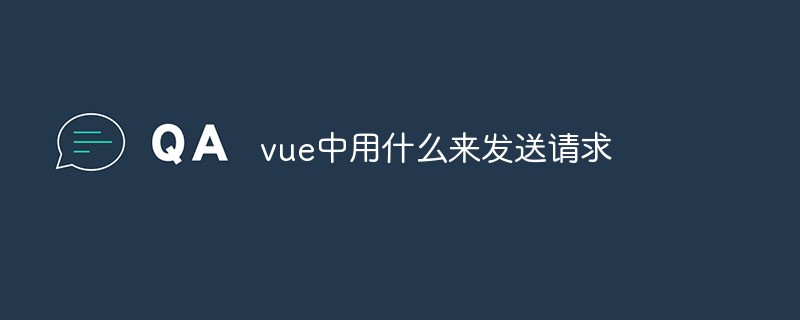ホームページ >ウェブフロントエンド >フロントエンドQ&A >vue でリクエストを送信するために何を使用するか
vue でリクエストを送信するために何を使用するか
- 青灯夜游オリジナル
- 2022-01-10 14:52:006591ブラウズ
vue では、リクエストを送信するには vue-resource、axios、およびその他のプラグインを使用する必要があります。 axios は、リクエストの送信に使用される Promise ベースの HTTP リクエスト クライアントです。vue2.0 でも公式に推奨されています。同時に、vue-resource は更新および保守されなくなります。

このチュートリアルの動作環境: Windows7 システム、vue2.9.6 バージョン、DELL G3 コンピューター。
Vue - http リクエストの送信に関する詳細な説明
1) Vue 自体は AJAX リクエストの送信をサポートしていないため、vue-resource などのプラグインを使用して実装する必要があります。そしてアクシオス。
2) axios は、リクエストの送信に使用される Promise ベースの HTTP リクエスト クライアントです。vue2.0 でも公式に推奨されています。同時に、vue-resource は更新および保守されなくなります。
axios を使用して AJAX リクエストを送信する
1. axios をインストールし、
1) を導入します。 npm 方法: $ npm install axios -S または cnpm install axios -S
2) bower 方法: $ bower install axios
3) cdn 方法: e990cf22afb90c441b995eb30bff9da52cacc6d41bbb37262a98f745aa00fbf0
2. axios
を導入して使用する方法その他をインストールする場合、main.js に直接 Vue.use() を導入することもできますが、axios は使用できず、リクエストを送信する必要がある各コンポーネントに直接導入することしかできません。この問題を解決するには、2 つあります。 開発アイデアは 2 つあります。
1 つ目は、axios を導入した後にプロトタイプ チェーンを変更することです。
2 つ目は、Vuex を組み合わせて aciton をカプセル化することです
オプション 1: プロトタイプ チェーンを書き直す
まず main.js に axios を導入します
import axios from 'axios' Vue.prototype.$http= axios
コンポーネントに http リクエストを送信します
this.$http.post('/user',{name: 'xiaoming'})
this.$http({method: 'post',url: '/user',data: {name: 'xiaoming'}})
//发送get请求
this.$http.get('/user?ID=12345')
.then(res=> { console.log(response); })
.catch(err=> { console.log(error); });
this.$http.get('/user',{params:{ID:12345}})
.then(res=> { console.log(response); })
.catch(err=> { console.log(error); });
//发送post请求
this.$http.post('/user',
{name: 'xiaoming'}
)
.then(res=> { console.log(res) })
.catch(err=> { console.log(err)}); 3. axios を次のようにカプセル化しますcall/**** request.js ****/
// 导入axios
import axios from 'axios'
// 使用element-ui Message做消息提醒
import { Message} from 'element-ui';
//1. 创建新的axios实例,
const service = axios.create({
// 公共接口--这里注意后面会讲
baseURL: '',
// 超时时间 单位是ms,这里设置了3s的超时时间
timeout: 3 * 1000
})
// 2.请求拦截器
service.interceptors.request.use(config => {
//发请求前做的一些处理,数据转化,配置请求头,设置token,设置loading等,根据需求去添加
config.data = JSON.stringify(config.data); //数据转化,也可以使用qs转换
console.log('请求拦截器中',config)
config.headers = {
'Content-Type':'application/x-www-form-urlencoded' //配置请求头
}
//注意使用token的时候需要引入cookie方法或者用本地localStorage等方法,推荐js-cookie
// const token = getCookie('名称');//这里取token之前,你肯定需要先拿到token,存一下
// if(token){
// config.params = {'token':token} //如果要求携带在参数中
// config.headers.token= token; //如果要求携带在请求头中
// }
return config
}, error => {
console.log('错误')
Promise.reject(error)
})
// 3.响应拦截器
service.interceptors.response.use(response => {
//接收到响应数据并成功后的一些共有的处理,关闭loading等
return response
}, error => {
console.log('error',error)
/***** 接收到异常响应的处理开始 *****/
if (error && error.response) {
// 1.公共错误处理
// 2.根据响应码具体处理
switch (error.response.status) {
case 400:
error.message = '错误请求'
break;
case 401:
error.message = '未授权,请重新登录'
break;
case 403:
error.message = '拒绝访问'
break;
case 404:
error.message = '请求错误,未找到该资源'
// window.location.href = "/"
break;
case 405:
error.message = '请求方法未允许'
break;
case 408:
error.message = '请求超时'
break;
case 500:
error.message = '服务器端出错'
break;
case 501:
error.message = '网络未实现'
break;
case 502:
error.message = '网络错误'
break;
case 503:
error.message = '服务不可用'
break;
case 504:
error.message = '网络超时'
break;
case 505:
error.message = 'http版本不支持该请求'
break;
default:
error.message = `连接错误${error.response.status}`
}
} else {
// 超时处理
if (JSON.stringify(error).includes('timeout')) {
Message.error('服务器响应超时,请刷新当前页')
}
Message.error('连接服务器失败')
}
Message.error(error.message)
/***** 处理结束 *****/
//如果不需要错误处理,以上的处理过程都可省略
return Promise.resolve(error.response)
})
//4.导入文件
export default service/**** http.js ****/
// 导入封装好的axios实例
import request from './request'
const http ={
/**
* methods: 请求
* @param url 请求地址
* @param params 请求参数
*/
get(url,params){
const config = {
method: 'get',
url:url
}
if(params) config.params = params
return request(config)
},
post(url,params){
console.log(url,params)
const config = {
method: 'post',
url:url
}
if(params) config.data = params
return request(config)
},
put(url,params){
const config = {
method: 'put',
url:url
}
if(params) config.params = params
return request(config)
},
delete(url,params){
const config = {
method: 'delete',
url:url
}
if(params) config.params = params
return request(config)
}
}
//导出
export default httpimport http from './http'
//
/**
* @parms resquest 请求地址 例如:http://197.82.15.15:8088/request/...
* @param '/testIp'代表vue-cil中config,index.js中配置的代理
*/
// let resquest = ""
// get请求
export function getListAPI(resquest,params){
return http.get(`${resquest}/getList.json`,params)
}
// post请求
export function postFormAPI(resquest,params){
console.log('发送post请求')
return http.post(`${resquest}`,params)
}
// put 请求
export function putSomeAPI(resquest,params){
return http.put(`${resquest}/putSome.json`,params)
}
// delete 请求
export function deleteListAPI(resquest,params){
return http.delete(`${resquest}/deleteList.json`,params)
} 解決策 Vue のクロスドメインの問題:
 解決策: スキャフォールディングの config の下にあるindex.jsで
解決策: スキャフォールディングの config の下にあるindex.jsで
これらの属性を dev
// Paths
assetsSubDirectory: 'static',
assetsPublicPath: '/',
proxyTable: {
"/api":{
target:"https://xin.yuemei.com/V603/channel/getScreenNew/",//接口域名
changeOrigin:true,//是否跨域
pathRewrite:{
"^/api":""//重写为空,这个时候api就相当于上面target接口基准地址
}
}
}, の proxyTable オブジェクトに追加します。次に、axios request を使用してここでリクエストします。リクエストするとき、プレフィックス API はベース アドレスと同等です。
axios.post("/api").then(res => {
console.log(res);
this.data = res.data.data;
});
//如果有参数请求
axios.post("/api?key=111").then(res => {
console.log(res);
this.data = res.data.data;
});
忘れずに再実行してください。設定後のプロジェクト (覚えておいてください)
2 つの方法で Ajax リクエストを送信したいと考えています
1 つ: XHR オブジェクト経由
リクエスト行:
メソッド: URL の投稿または取得: リクエスト アドレス##リクエスト ヘッダー:
host: ホスト アドレス
#cookie
content-type: リクエスト本文の内容
リクエスト本文:応答行: ステータス
応答ヘッダー: 複数の応答ヘッダーResponse body:json/picture /css/js/html2: フェッチ関数を通じて
#[関連する推奨事項:vue.js チュートリアル
]
以上がvue でリクエストを送信するために何を使用するかの詳細内容です。詳細については、PHP 中国語 Web サイトの他の関連記事を参照してください。

